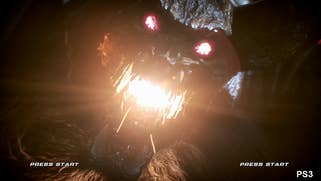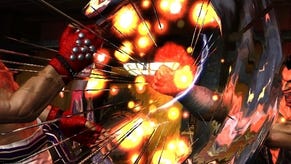Face-Off: Tekken Tag Tournament 2
You don't know Jack.
| - | Xbox 360 | PlayStation 3 |
|---|---|---|
| Disc Size | 7.9GB | 17.1GB |
| Install | 7.9GB (optional) | 7382MB (mandatory) |
| Surround Support | Dolby Digital | Dolby Digital, 5.1LPCM |
In Tekken 6, we found Namco juggling image quality and performance while implementing an impressive object blur effect to enhance the look of the game, resulting in two very different rendering set-ups for each console. Both versions adopted a sub-HD framebuffer set-up (1024x576) with no anti-aliasing due to the computationally heavy requirements of including the object blur effect.
However, turning off the effect yielded dividends on both consoles - anti-aliasing was enabled on PS3 and a 1365x768 resolution downscaled to 720p on Xbox 360 provided a small amount of super-sampling. Turning off one of the most impressive effects arguably improved the game, and it's clear that the developers weren't so happy about that, adopting a new approach for the sequel.
With Tekken Tag Tournament 2, Namco has found a good middle-ground between including their show-stopping object blur effect and maintaining the solid 60FPS required for the deep and responsive gameplay the series is known for. The initial rendering resolution has been upped considerably, and the engine has also been refined and optimised to allow for up to four characters to appear on screen at once. Some of the environments feature convincing multi-tiered elements, while the characters themselves are still some of the most detailed to grace a fighting game to date: polygon counts are high and the quality of the animation is excellent.
All of this combines to create a rather slick experience overall, although not without a few compromises. As an opening look at our head-to-head video (and accompanying comparison gallery) reveals, image quality lags behind competing fighting games, the highly impressive object blur effect limiting the extent of the graphical upgrades in other areas. In some places the lighting model can appear rather flat, despite the inclusion of lens flare, light shafts and bloom.
"The sub-HD presentation of Tekken 6 is replaced with a brand new approach which sees resolution adjusting on the fly according to the load exerted on the core rendering technology."
Rather than render at a fixed sub-HD resolution, Tekken Tag Tournament 2 operates using a dynamic framebuffer, where the resolution is adjusted on the fly depending on the rendering load. For performance reasons, anti-aliasing has been also been completely omitted to free up GPU resources for Namco's impressive object blur effect. Both versions kick off running natively at 720p when there are just two characters on screen. As things heat up and combat intensifies the engine tends to drop the resolution down to a more manageable 1024x720 for extended periods of time: image quality is only slightly impacted, and we still get the feeling that we are looking at a near-HD presentation. It's certainly a step up from the fixed 1024x576 resolution we saw in the demo bundled with Tekken Hybrid.
Switching between characters and performing tag-team combos results in more severe compromises: according to a tech presentation given by Namco in Japan, the resolution is adjusted in various steps, with 900x720, 800x720, and 720x720 all being seen at various points. Resolution is pared back to its maximum extent when there are all four characters on screen in scenes which really tax the engine, and also in 3D mode where the rendering load is doubled up to generate distinct views for each eye.
Interestingly, on one particular stage we also find that motion blur is dynamically adjusted on the 360 (mostly likely for performance reasons), while the default framebuffer resolution is lower on the PS3. It's virtually impossible to spot during gameplay, but in this situation it looks Namco could be taking advantage of the extra computational grunt provided by the PS3's Cell processor and the onboard SPUs in rendering the blur effect while maintaining that important 60 frames per second update, with a small drop in resolution being the trade-off.
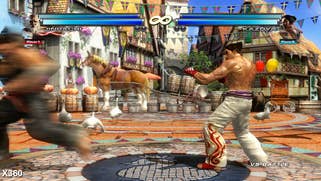
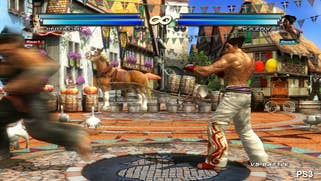
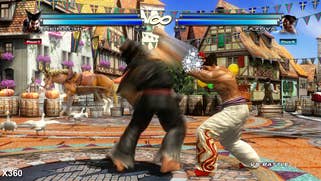
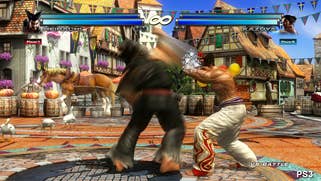
Similar to Tekken 6, the option to toggle between playing with motion blur on or off makes a return for this sequel. However, the dynamic framebuffer set-up remains firmly in place and there are no additional image quality enhancements beyond the game running at higher resolutions for longer periods of time. Without blur enabled, Tekken Tag 2 spends most of its time running natively in 720p with only minor drops down to 1024x720 during intense matches when there are two characters on screen. More heated scenes result in further drops to resolution, but the effect is only seen sporadically - and nowhere near as much as with the blur effect enabled.
Despite image quality taking a hit in terms of the level of jaggies and edge shimmering on-screen, the decision to go with a dynamic resolution set-up in order to maintain a solid 60FPS update appears to be the right choice - at least in the case of having motion blur activated, where the low 1024x576 resolution of Tekken 6 (without AA) created a rough-looking game overall, and this is something that Tekken Tag 2 mostly avoids when the engine isn't being stressed too heavily. That said, it could be argued that the PS3 version of Tekken 6 running without motion blur enabled still manages to feature better overall image quality, due to featuring 2x MSAA and a higher level of AF, with a slightly softer presentation being the trade off.
Namco's use of object blur in Tekken Tag 2 is still a worthwhile inclusion though, adding an extra level of ferocity to the fights and providing a smoother and more natural look to the animation. The effect is one of the most complex we've seen in any game to date: it appears to be rendered using two 1280x360 buffers in interlaced format before being combined with a velocity map. The interlacing does create some unsightly scanline-type artifacts in some of the post-fight sequences, but also ensures that the effect is completed within the tight 16.67ms window required for running the game at 60FPS.
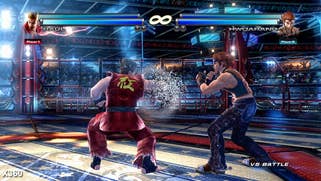
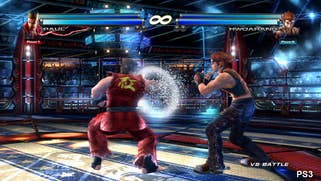
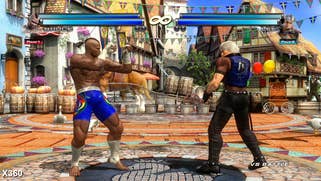

Beyond the interesting framebuffer set-up employed in the game, there are very few differences between the platforms. Just like Tekken 6 and Soul Calibur 5 before it, Namco has handed in a very close multi-platform conversion in which any graphical quirks between consoles have no real impact on the overall look of the game.
Texture detail is identical, with slightly better use of filtering on the 360 being the only point of difference in this regard, while elsewhere we find that the odd light source is missing on the PS3 in some stages. Alpha buffers for certain effects (such as contact flash elements) also appear lighter and less defined on the 360 - perhaps as a result of a difference in how texture formats or the alpha channel is handled on each console - while a difference in gamma set-up adds slightly more depth to images on the PS3, due to that version appearing slighter darker. Elsewhere, both versions make use of some very low resolution shadows, which clearly appear very pixelated when these effects are close to the camera.
A look at the disc sizes reveals an interesting difference: the 360 game weighs in at 7.9 GB while the PS3 version occupies a whopping 17.1 GB of space on the Blu-ray disc. Inspection of the game's FMV sequences reveals superior quality encodes on the PS3, with higher bit-rates providing footage that contains very few compression artifacts. In comparison, macroblocking can be clearly seen on the 360 in brighter scenes.
Elsewhere, loading times are similar in length when navigating through the menus, although they are a few seconds longer on the Sony platform before each match. The PS3 features a mandatory 7382MB installation (which takes around 15 minutes to compete) before you can first play the game. You can optionally install the 360 game, taking up 7.9 GBs of hard drive space in the process.
Tekken Tag Tournament 2: Performance Analysis
In terms of performance, maintaining a solid 60 frames per second during heated fights both online and off is essential to the core gameplay mechanics on offer in the game. Timing and controller responsiveness is everything in a fighting game where every frame counts. The Tekken series may not be as demanding as Virtua Fighter in this regard (to be honest, no fighting game is) but any variances in latency can mean the difference between a victory and defeat in stressful fights fought on a knife's edge.
The game's online mode and Replay Theatre option give us a great way of putting performance to the test: here we can cherry-pick fights by experienced players which contain more in the way of tag team combos and fast, frenetic gameplay in order to stress-test the engine. As expected, Tekken Tag 2 targets a 60FPS update, which is essential for providing the fast and responsive controls the series is known for, delivering a buttery smooth gameplay experience into the bargain. But how well does Namco's dynamic framebuffer solution work in keeping a steady frame-rate with a bare minimum of dips in performance?
Let's start by taking a look at the 360 game with motion blur enabled - the default setting used by both the arcade and console releases.
"Dynamic resolution scaling appears to pay off - Tekken Tag Tournament 2 maintains its 60FPS update admirably, even in the most frenetic tag team situations with four fighters on-screen."
In short, Namco's solution does an excellent job indeed. Throughout demanding fights - which see four characters on screen at once executing large combo strings - the frame-rate stays locked at 60FPS, besides the odd two-frame drop and singular torn frame, which only occurs on the rarest of occasions and certainly won't be noticed by anyone other than top-tier professional players. The result is that gameplay feels consistently smooth and responsive with the dynamic framebuffer implementation ensuring that the rendering load is kept in check.
The only times we actually see slightly more visible dips in performance come from the replays and post-fight sequences, where frame-rates become a little more variable. Even here, the game never drops more than a few frames and obviously there is no impact on gameplay at these scripted points.
There are no unwanted surprises where the PS3 version of Tekken Tag 2 is concerned either, where performance is basically a match for the 360 game. The more eagle-eyed may notice that the two frame dips occasionally present on the 360 during tag team moves happen a little more often on the PS3, but the impact of this is extremely limited, to the point where it is basically unnoticeable during play.
"Frame-rate only ever dips to any noticeable degree during replays and post-fight sequences, but where it matters - in-game - Tekken Tag Tournament 2 is remarkably solid."
Overall, the trade-off in terms of screen resolution in order to achieve a solid 60FPS while running with motion blur enabled appears to be a good one, the effect definitely adding a more visceral feel to the action. Each blow feels that much more satisfying and the buttery smooth nature of the blur in combination with the high frame-rate clearly adds to the experience. This feat is made even more impressive when you consider that Namco's engine is actually managing to stick very closely to native 720p when it isn't pushing more than two characters on screen - a massive leap from the 1024x576 resolution of Tekken 6.
Stereoscopic 3D Analysis
In something of a surprise move, Namco has also included stereoscopic 3D options in Tekken Tag 2, with the amount of depth being directly adjustable by the player. This is rather unexpected because both consoles are already being pushed to their limits with the additional processing requirements that Namco's object motion blur places on the engine, not to mention the strict requirement for a 60 frames per second update.
First impressions are promising though: the initial pre-fight sequences reveal a native 720p presentation with no anti-aliasing - a match for the game running without motion blur in 2D mode in less stressful scenes. However, once the fight begins it is clear on exactly just where Namco has made cuts in order to accommodate the stereo effect. Motion blur is completely absent (even if the option is still selected in the display settings menu) and the framebuffer has been pared back significantly on both consoles, with the game regularly rendering out resolutions as low as 800x720 and 720x720 as the engine attempts to try and maintain the desired 60FPS refresh.
"Stereo 3D support sees the dynamic resolution system pushed to its limits - and beyond. Frame-rate suffers even with resolution as its lowest: 720x720."
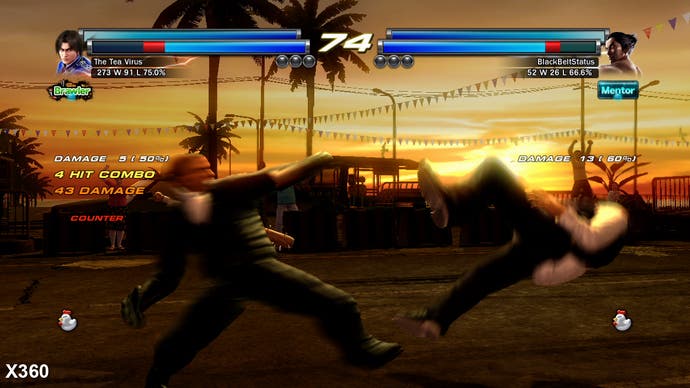
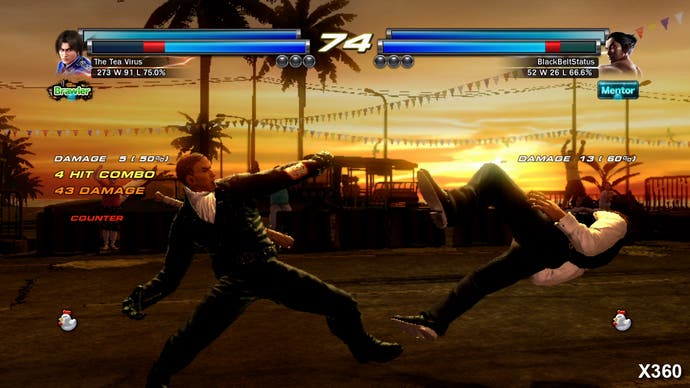
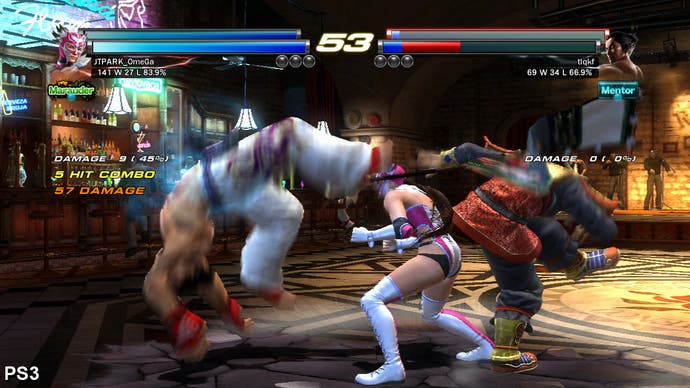

As a result image quality leaves much to be desired. The game is covered in a veil of softness which blurs out finely detailed textures, while the lack of anti-aliasing and additional upscaling artifacts creates images which are full of shimmering edges and unavoidable jaggies. The reduced level of anisotropic filtering on the PS3 actually makes that version look slightly blurrier, although neither emerge with much credit in this regard. However, on the plus side, character and environment modelling appears to be on a par with the game running in 2D, and bar the absence of motion blur, all of the other effects (such as the use of contact flashes) appear to be correct and present.
There is a noticeable gap in terms of performance between both consoles though, with the 360 consistently commanding a noticeable lead throughout, as you can see in this additional video analysis. A solid 60FPS is off the cards for both consoles here, but it's clear that Sony's system is having a tougher time in meeting that ambitious target. Frame-rates regularly drop down to the 40FPS mark on the PS3, bottoming out at 30FPS, with less stressful scenes resulting in a distinct lack of smoothness.
In comparison, the 360 manages to hit its 60FPS target when there is little to tax the engine. When the action hots up, there are regular frame-rate drops where we see performance hitting a low of 40FPS. It's not great, but generally speaking, frame-rates aren't quite as erratic as they are on the PS3. Nevertheless, control responsiveness is noticeably impacted on both versions (more so on the Sony platform) and because of this, we can't really recommend playing Tekken Tag 2 using the stereoscopic mode. It's an interesting curiosity and could find favour in a more casual gaming scenario but the plain and simple fact is that the 2D mode looks and plays better.
"Of the two versions, the Xbox 360's stereoscopic 3D support is significantly smoother than the PS3's, but the basic fact of the matter is that it's still nowhere close to the precision feel of the core 2D Tekken experience."
Tekken Tag Tournament 2: The Digital Foundry Verdict
Namco's curious experimentation with the rendering set-up in Tekken 6 felt conspicuously like a work in progress: the compromise in resolution and overall image quality was perhaps a little hard to accept given the sharp 720p presentation offered up by the arcade game and Namco's competing Soul Calibur series on the current generation consoles.
There are far fewer complaints with Tekken Tag 2. Jaggies and image quality aside, the use of a dynamic framebuffer works very well in providing us with a sharper image - and one which only becomes compromised when the engine is put under stress. Further benefits can be enjoyed by playing the game without object blur enabled for a generally higher resolution presentation outside of performing tag team combos. The 3D mode is far less impressive though, and we feel that the variable frame-rate and controller responsiveness makes this option more of a curious diversion rather than a serious alternative to playing the game in 2D.
"Online friends lists and controller options are far more instrumental to the purchasing decision here than the technical merits of the two versions."
Beyond the various engine tweaks and inclusion of stereoscopic support, the conversion is nicely handled across both consoles and the small differences which creep in from time to time are barely visibly during play, and as such have no negative impact on the core look of the game. Instead, when it comes down to which version you should opt for, the final decision should rest upon which online service your friends are using (PSN or XBL) or which controller you most prefer. The default Dual Shock 3 pad on the PS3 is arguably better than the 360's wireless pad for fighting games, due in no small part to the superior d-pad on Sony's controller. However, players on both systems are well catered for with a range of budget and high-end arcade sticks and controllers that are perfectly designed around the needs of fighting game purists.
If there's any criticism to level at the game, it's perhaps simply down to the fact that the gameplay feels so familiar, coming up rather short on surprises. Perhaps it might be time for a greater number of original characters along with a more forward-thinking evolution of the series' trusted chain-combo based gameplay mechanics - the revolution in physics fidelity in particular seems to have escaped most fighting games this generation. While the series may need freshening up with some new ideas for the next instalment, in the here and now, Tekken Tag Tournament 2 represents a suitable refinement over its predecessor in terms of the gameplay and character selection, and while short on surprises, it's simply great fun to play.


